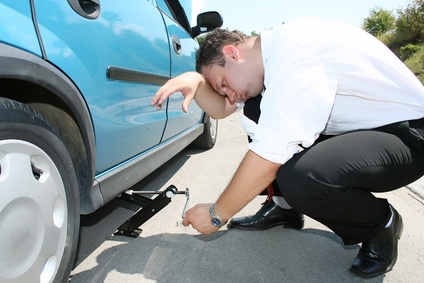
There is no grand trick to changing a tire on a Chevy Suburban, but because the vehicle is large and heavy, it does take some effort -- and some precautions. Unlike some manufacturers, Chevrolet posts free PDFs of owners manuals online, so information is readily available. Chevy says blowouts are rare on Suburbans, so you so may be dealing with a slow leak. Regular checks of your air pressure will keep slow leaks from sneaking up on you and give you time to get the vehicle to a dealer before you have to resort to the jack.
Get on level ground. Never attempt to change a tire if the Suburban is not on level ground. If you cannot drive a short distance to level ground, call for help. If the Suburban rolls off of the jack while you're trying to change a tire, you can be severely injured or killed.

Secure the vehicle. Once you are on level ground, set the parking brake firmly and put the shift lever into the P (Park) position. If your Suburban has four-wheel drive, be sure the transfer case is in a drive gear, not in neutral. Turn the engine off and leave it off. Get passengers out of the vehicle. Put the wheel blocks at the front and rear of the tire opposite the tire you have to change. If you're changing the right rear tire, for example, put the blocks on both sides of the left front tire.
Get the tool kit from its storage area. You'll find the storage under the storage tray that sits, inside the vehicle, on the left rear wheelhouse. Lift the tray out by pulling on the finger depression under the jack symbol. The jack, tool kit and wheel blocks are held in place by two wingnuts and one knob. Remove them to access the tools. If any of the tools are missing, call for help.
Remove the spare tire from its storage compartment. First, open the hoist access cover, which is on the rear bumper, to the right of the license plate. Inside the access hole, insert the ignition key into the spare tire lock, turn it clockwise, then pull the lock straight out.
Next, connect the two jack handle extensions, then insert one into the matching hole in the handle of the wheel wrench, forming a T.
Then, insert the open end of the extension into the hoist access hole, and secure it snugly to the hoist shaft. Turn the wheel wrench counterclockwise to lower the spare tire all the way to the ground. Keep turning until there is some slack in the hoist cable.
Pull the spare tire toward you, then tilt it up toward the bumper so that you can reach under it.
At the end of the hoist cable is the tire retainer and a guide pin. Pull down on the guide pin, align the retainer with the cable, and thread the entire assembly through the center hole in the wheel. Set the spare tire near the tire you need to replace.

Loosen, but do not remove, the lug nuts on the wheel with the flat tire. If your vehicle has a cap that covers the lug nuts, use the chisel end of the wheel wrench to gently pry it off.

Position the jack on the frame behind the flat tire where the frame sections overlap. If a front tire is flat, you will only need one of the jack handle extensions. If a rear tire is flat, you'll need two. Once the jack is in position, turn the wheel wrench clockwise, raising the car just high enough to remove the flat tire.
Remove the loosened lug nuts, then the flat tire. Clean debris and rust from the bolts, then place the spare tire on the hub. Tighten the lug nuts evenly, by hand. Loosely tighten one lug nut, then loosely tighten the one opposite it. Continue tightening lug nuts in a crisscross pattern until the wheel is held snugly to the hub. Tighten the nuts further with the wheel wrench. When all of the lug nuts are tightened, turn the wheel wrench counterclockwise to lower the car. When the spare tire is firmly on the ground, finish tightening the lug nuts.

Gather your tools and the flat tire, and store them in the car. Do not drive a long distance on a flat tire, and do not use four-wheel drive. As soon as possible, take the flat tire to a dealer or repair shop and have it patched or replaced.
